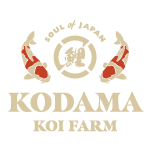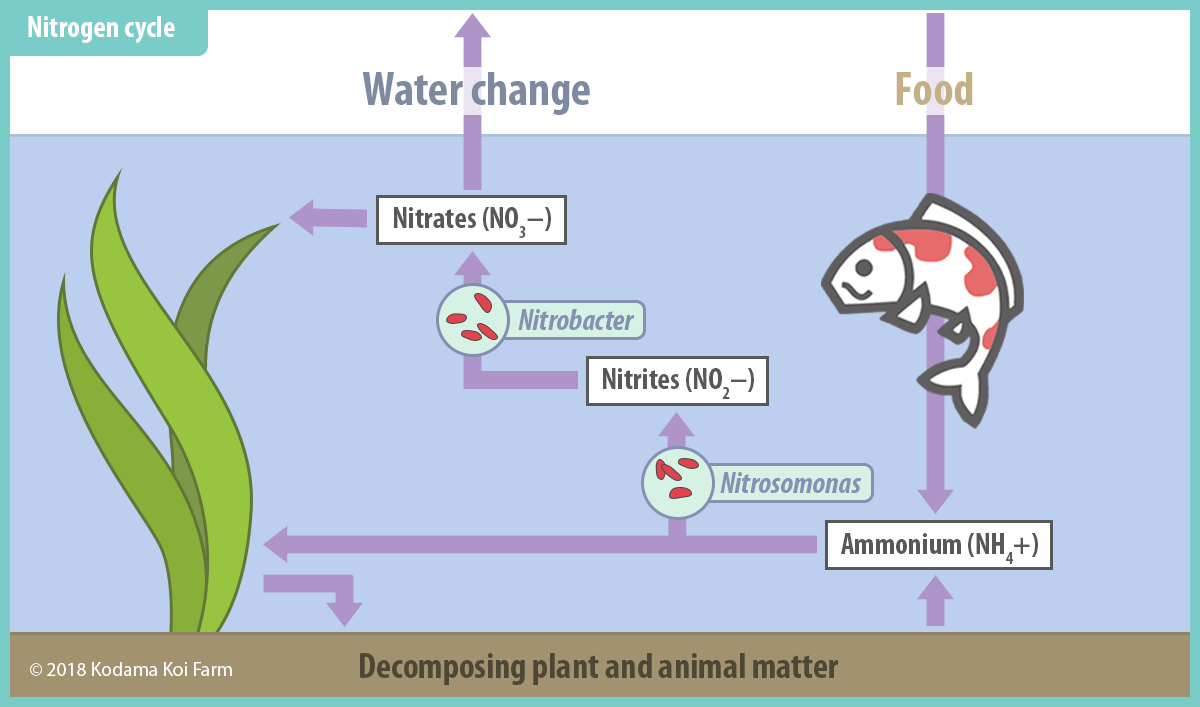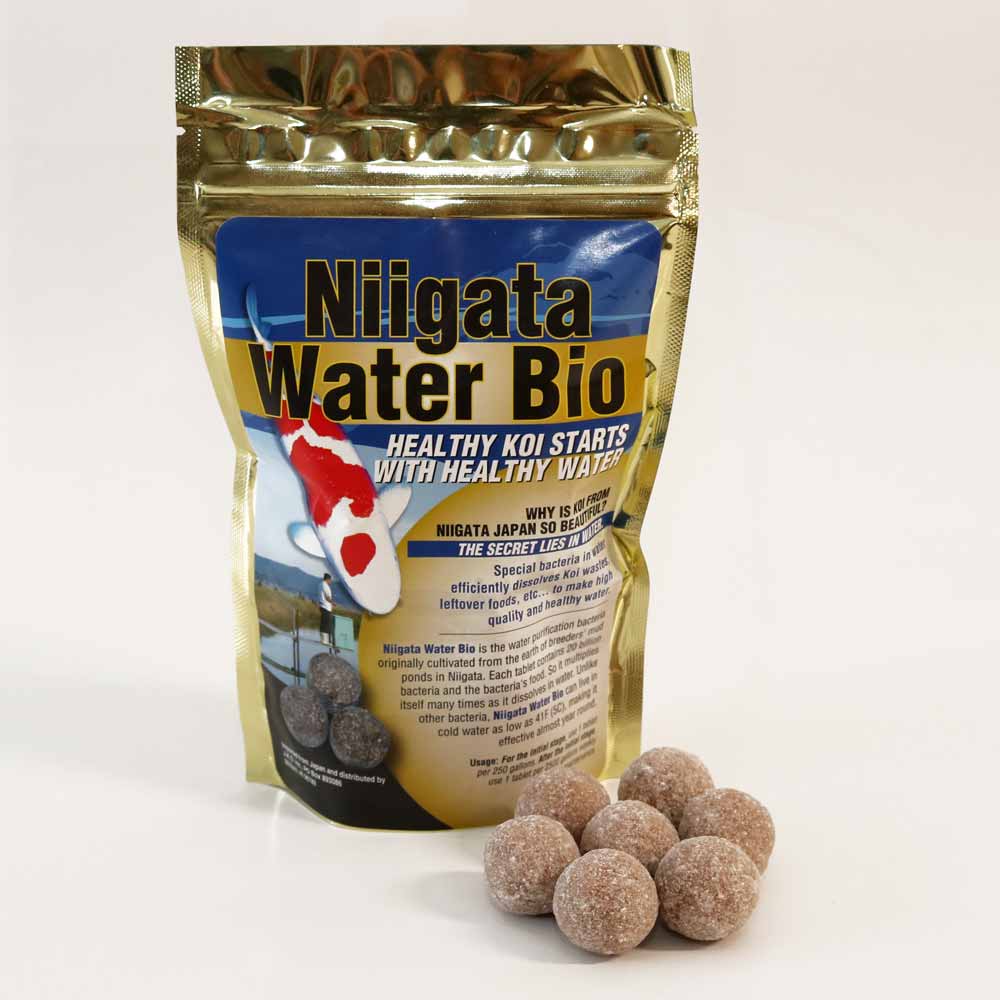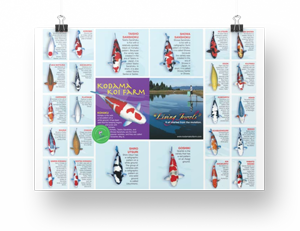Did you know that about 75% of a fish’s body is water, just like 60% of your body is water?
This means it is even more important to have healthy water for Koi than humans. When you consider that Koi live and breathe in water, you can tell how much of an impact that water quality affects Koi health.
The purpose of our writing this blog post to give you a foundation of the nitrogen cycle in your pond so you can maintain healthy water for your Koi. We will also explain our best product recommendation for keeping your water healthy. Good luck and happy ponding!
Nitrogen Cycle of your Koi Pond Graphic
We created this graphic to show the parts of a pond’s cycle and decomposing plant and animal matter.
To keep water quality safe for Koi, the nitrogen cycle must follow the process shown below:
Understanding the Nitrogen Cycle
- Koi eat food and produce waste. The food that Koi do not eat also decompose. Both of these release ammonia. Ammonia is very toxic and dangerous to Koi. An ammonia level of 0 is required.
- Nitrosomonas is a nitrifying bacteria. They consume ammonia and convert them to nitrites. However, nitrites are still toxic to Koi. A nitrites level of 0 is required.
- We need help of another type of nitrifying bacteria—nitrobacter. Nitrobacter consume nitrites and convert them to nitrate. Nitrate is not toxic to Koi.
- Nitrates can be easily removed from the system by a water change, or aquatic plants and algae can consume them.
To keep water healthy for Koi, there are many other topics to understand.
However, understanding your pond’s nitrogen cycle is your essential first step to pond management success.
Your Pond’s Need for Bacteria
In this chart above, you can see the important role of beneficial bacteria. Without these 2 kinds of beneficial bacteria, water will harbor toxic ammonia and nitrite and harm your Koi’s health. Even if the water is clear, the existence of ammonia and nitrite means unhealthy water. To keep ammonia and nitrite levels at 0, it is critical that your pond system always host enough beneficial bacteria.
Other reading: How to make medicated koi food for bacterial infections
Your Pond’s Need for Oxygen
Your pond needs more oxygen than you probably expect. Koi need oxygen, of course; but these beneficial bacteria need it, too. (Bacteria that need oxygen are called aerobic bacteria). On top of that, algae consumes oxygen; and when debris decomposes, oxygen is reduced further.
Recommendations for Koi Pond Owners
If your pond is new, the nitrogen cycle is not established yet. So it is important to seed the pond with beneficial bacteria. If your pond is already established, I still recommend you add the bacteria on a regular basis, around once a week.
Koi eat and produce waste every day. The ecosystem changes every day. To keep everything balanced, I feel it is wise to add beneficial bacteria regularly and maintain the bacteria count consistently.
Niigata water bio balls are one of our top selling items and our customers love it’s ability to help maintain a healthy ecosystem. We always recommend natural biological filters for your pond. You may also consider reading about our custom created koi pond filter.
Niigata Water Bio
There are many beneficial bacteria products on the market. Any of them will do the job, but let me introduce my favorite.
Niigata Water Bio is our favorite on the farm for several reasons:
- First of all, this Japan-made product contains about 20 billion beneficial bacteria and their food in each small tablet. So as soon as it is dropped in your pond and dissolved, they can multiply themselves quickly.
- Secondly, it may surprise you to know that the bacteria in Niigata Water Bio can live in cold water as low as 41F. So it works great even at the beginning of spring and fall when Koi are slow-moving and have low health immunity.
- Lastly, this product has been very popular in Japan for the last few decades since around 1988—meaning it works.
If you are looking to improve the biological filter and nitrogen cycle in your pond, than we highly recommend you try Niigata Water Bio.





My fish didn’t eat as much as normal at the end of the summer. I had a bunch of pine needles blow into the water and I cleaned them out as best I could.then started seeing small red worms in filter.are these the cause of the problem. Please help
I do not know if they are the cause of the problems. Let’s start from the basics. Please check your water parameters if you have not done so? Please check your water temperature. They do not and should not eat as much when water temperature is cold.
Just lost five big koi fish, change the water and put Japi stress coat + in new water, fish still not eating, Sorry
Hello, I have recently added a small pond to my backyard. How long do I have to wait before adding Koi? Is it dangerous to add before the pond matures?
As long as your water is treated, you may start. Please make sure you start small with a few Koi so your filter is not overloaded.
those small red worms maybe bloodworms. bloodworms are present in nicely conditioned water system. it is neither harmless to both Koi and humans. Kois love it for dessert.
Just noticed one of my koi is sick. Half of his tail fin is gone, his tail is bent at a 30degree to 40degree angle and he cannot use his tail very well to move. He has dropped weight. Noticed some redness on his body in spots. Hard to upright himself to get food. He has lost 1/2 his body weight?? Its the weekend, I don know a Vet who would specialize. I inherited a 1/4 acre pond with about 15 Koi in it. There is a waterfall for aeration. All the other Koi are fine. Im thinking a predator might have attacked him. I call him Big Boy because he was the largest and looked like a 747 coming down the line when I go out to feed them. Any help would be wonderful. Im calling a Vet in the am.
Every spring we have 3 or 4 koi w ulcers on their side & also get them occasionally in summer. I have taken sick fish to vet & we have to treat them for bacterial infections. Have to inject the sick fish every third day which usually takes care of problem but stressful for koi to catch sick ones. & keep in separate place. How can I avoid this spring time illness?
Hello I am sorry for the experience. If you experience this every year, good chances are that the pathogens lives in your system like filters or gravels at the bottom if you have. I would move all the Koi to a holding tank and disinfect the entire pond and the system completely. If you would like to discuss more, please email us at info@kodamakoifarm.com with your pond pictures.
my koi pond is crystal clear the water test are fine. I had a thin layer of algae on the side, that is now black like it died. Should I remove this black stuff. Fish are healthy and happy. I heat the water to 65f.
Yes, I would recommend removing it.
Hello, I understand that in winter the nitrifying bacteria decrease their activity, even die, in my country (Mendoza, Argentina), the water temperature is 6°C (approximately 42°F), that would indicate that all the beginning of the season the pond starts the cycle again?